A Short History of the Hemingray Glass Co. - Part 3 of 4
by H. G. "BEA" HYVE
Reprinted from "INSULATORS - Crown Jewels of the Wire", January 1982, page 13
In 1893 the "drip point" patent was awarded to Ralph Hemingray and James C. Gill.
James Gill was a mold maker for the company as early as 1884. By 1886 he was a
foreman mold maker, moving to Muncie in 1890 as foreman of the mold shop there.
The drip points, located on the bottom of the base of the insulator, were
supposed to "take all the moisture from the inner and outer surface of the
insulator and keep the pin dry", according to a company ad.
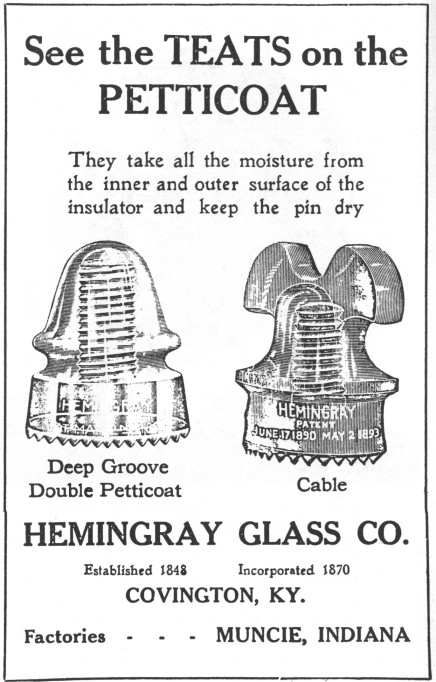
Large Image (162 Kb)
Robert
Hemingray, founder of the company fifty years before, died in December of 1898.
Ralph became president and another of Robert's sons, Robert Jr., became
vice-president. A younger son, Daniel, became secretary-treasurer. (Daniel died
in 1911).
As the telegraph and telephone industries gained in importance in the
late 1890's, the company began to concentrate more on the manufacture of
insulators to better serve the increasing demands. The Hemingray Glass Co. soon
became known the world over as the leading producer of glass insulators. Their
insulators carried the company's name to most of the American continent as well
as to almost every civilized country in the world. Insulators remained the
mainstay of the company until the late 1920's (at which time bottle production
was reinstated).
By the early 1890's the Muncie plant had been expanded to the
point where it was able to take care of the trade, and production at Covington
ceased. According to the invoice reproduced on the following page and dated
1896, it appears that Covington remained for a time as a warehouse with some
offices there also, while the main headquarters and factory were at Muncie.
Covington was eventually closed, about 1919. (More on that later on). Also
around 1898 to 1900 it is reported that the Hemingray Glass Co. had a sales
office in St. Louis, Missouri. The exact location is unknown at this time, due
to insufficient time for researching this information.
In 1901 Robert Hemingray
Jr. died, and his brother-in-law, Bradford Shinkle, became vice-president. (This
post was taken over by his son, A. C. Shinkle, about 1920).
In 1904 the
Hemingray Glass Co. is listed in the directory as having three continuous tanks,
with eighteen working rings and one day tank with six rings. A glassmaker
explained this to me, saying that this refers to the number of hand workers
around each tank of glass, and that "continuous" means that the
furnaces were kept hot 24 hours, 7 days a week, and were only cooled down when
repairs had to be made. This same year of 1904 saw the addition of a second
furnace, called "B" furnace. These furnaces were huge affairs, the
interiors of which were as large as some living rooms. (Both "A" and
"B" furnaces still exist at the Muncie site).
"B" furnace,
which is larger that "A" furnace, measures (inside) approximately 20
feet long by 16 feet wide by 15 feet high. The photos on the next two pages show
the interior of "B" furnace, and were taken at various times over the
years when it was shut down for repairs or renovation.
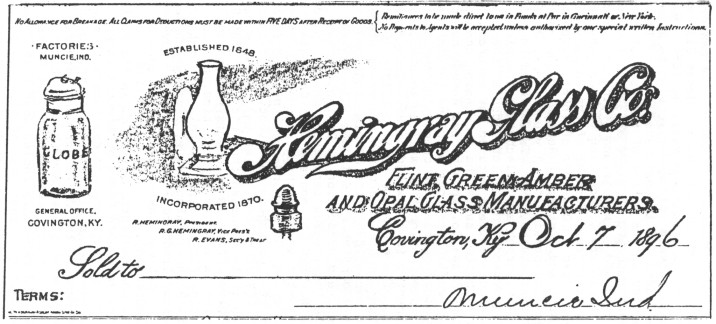
Large Image (188 Kb)
Hemingray Glass Co. invoice -- 1896
(Restored by author)
(Courtesy of Mike Sovereign and Ern Parkison)
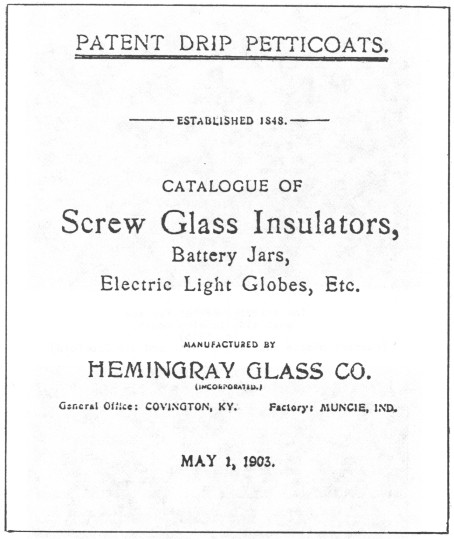
Large Image (89 Kb)
1903 Catalog
(Restored by author)
(Courtesy of Mike Sovereign)
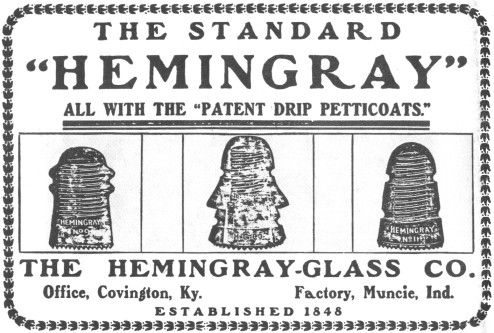
Large Image (98 Kb)
Telephony, December 1904
(Courtesy of Glenn Drummond)
From 1904 issue of
Telephony we read, "At the present time the claim is made that the
Hemingray Glass Co. is not alone the largest establishment of its kind in the
world, but that its yearly output and sales are more than those of all other
insulator manufacturing industries combined. It manufactures annually many
millions of insulators, all of which find a ready market. The factory at Muncie,
Indiana, is kept running day and night, but even with the plant working to its
outside limit, the company reports that it is behind in its orders. The offices
of the concern, at Covington, Kentucky, are a busy hive of industry." It
goes on to say that the company, more than any other agency, was particularly
successful in producing superior high voltage insulators.
In the 1910 Official
Gazette of the United States Patent Office, a description of Hemingray's goods
reads, "Electric, Telegraph, Telephone, Cable, Street-Railway, and Floor
Insulators and Break-Knobs of Glass." And by about 1918 insulators had
become the sole product of the Muncie plant.
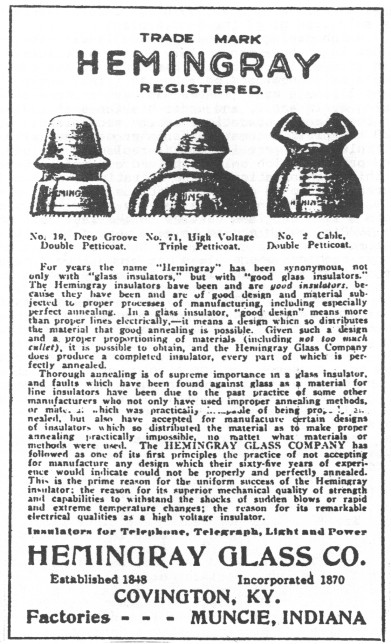
Large Image (198 Kb)
The Electrical World (?), 1913
(Courtesy of Mike Sovereign)
| 